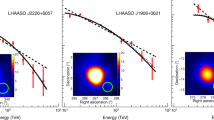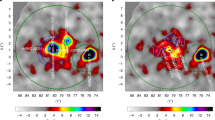Summary
Cosmic ray stars have been investigated at 3500 m using an ion chamber surrounded by G.M. counters connected to a 22 channel hodoscope. The events were recorded by a tele-typewriter triggered by the hodoscope, so that a reconstruction of the mutual positions of the stars prongs could be obtained for each event. The analysis reported here refers to about 13 000 stars having eitherat least one secondary branch able to cross 1.2 g/cm2 of brass orno such branch. These «detectable prongs» were protons of energy greater than 25 MeV or mesons of energy greater than 10 MeV. Using photographic emulsion results it is shown that the average energy,\(\bar W\), of the nucleons producing our interactions is about 60 MeV for the stars without detectable prongs and in the neighbourhood of 750 MeV for the stars having at least one prong. The zenith angle distribution of these nucleons is well represented by cosm z andm varies from 2.1±.3 to 2.6±.3 between\(\bar W = 60 MeV\) and\(\bar W = 750 MeV\). It is found, furthermore, that roughly the same distribution holds for both proton and neutron forming stars. The angular distributions of the secondary prongs have been deduced with respect to the vertical and to the direction of the primary. Analytical expressions in terms of power of the cosine of the angle are obtained for the experimental distributions referring to the projections of the tracks on a plane. The distributions in space are derived from these plane distributions through the solution of an integral equation, and they are polynomials of the same type. Comparison of our distributions with those obtained from analysis of stars produced by 300–400 MeV nucleons, suggests that:a) the cross-section for meson production is still very small at energies of 700–800 MeV;b) the cross-section for elastic scattering in nucleon-nucleon interactions remains probably almost constant between 300 and 750 MeV.
Riassunto
Per mezzo di una camera a ioni, circondata da contatori G.M. connessi con un odoscopio a 22 canali, si studiano le caratteristiche angolari delle «stelle» prodotte dalla, componente nucleonica dei raggi cosmici a 3 500 m sul l.d.m. Gli eventi sono registrati da una telescrivente Olivetti comandata dall’odoscopio. Le lettere indicate dalla telescrivente permettono di ricostruire le posizioni mutue dei «rami» emessi in ciascun evento. I risultati qui riportati sono basati sulla analisi di circa 13 000 stelle. Sono state considerate in particolare stelle aventinessuno oppurealmeno un ramo capace di attraversare le pareti della camera e dei contatori. Questi «rami rivelabili» sono protoni di energia maggiore di ∼25 MeV o mesoni di energia maggiore di ∼10 MeV. Utilizzando risultati di osservazioni in emulsioni fotografiche, si riconosce che l’energia mediaW dei nucleoni che producono le interazioni da noi osservate, è di 60 MeV per le stelle senza rami rivelabili e di 750 MeV per le stelle con almeno un ramo. Si trova che la distribuzione zenitale di questi nucleoni si può rappresentare bene con cosm z (z=angolo zenitale;m=2,1±0,3, per\(\bar W = 60 MeV\) em=2,6±0,2 per\(\bar W = 750 MeV\)), questo risultato essendo valido sia per i protoni, sia per i neutroni. Si ricavano inoltre le distribuzioni angolari dei rami secondari (sia rispetto alla verticale, sia rispetto alla, direzione del primario), in proiezione su un piano normale all’asse del dispositivo. Attraverso la soluzione di un’equazione integrale si ottengono le distribuzioni angolari nello spazio partendo dalle corrispondenti distribuzioni «piane». Tutte le distribuzioni angolari considerate si possono rappresentare bene con polinomi nel coseno dell’angolo. Il confronto delle nostre distribuzioni angolari con quelle ottenute da analisi di interazioni nucleari prodotte da nucleoni (accelerati artificialmente) di 300–400 MeV, suggerisce:a) che la sezione d’urto per produzione di mesoni è ancora molto piccola (<∼10%) ad energie di 700–800 MeV;b) che la sezione d’urto per «scattering» elastico nell’interazione nucleone-nucleone, si mantiene probabilmente quasi costante tra 300 e 750 MeV.
Similar content being viewed by others
References
R. H. Brown, U. Camerini, P. H. Fowler, H. Heitler, D. T. King andC. F. Powell:Phil. Mag.,40, 862 (1949);N. C. Barford andG. Davis:Proc. Roy. Soc., A214, 225 (1952);M. Morand andTsai-Chu:Compt. Rend.,235, 1502 (1952).
P. Bassi, C. Manduchi andP. Veronesi:Nuovo Cimento,9, 722 (1952).
C. E. Miller, J. E. Henderson, D. S. Potter, J. Todd, Jr.,W. M. Sandstrom, G. R. Garrison, W. R. Davis andF. M. Charbonnier:Phys. Rev.,93, 590 (1954).
E. Gardner andW. Peterson:Phys. Rev.,75, 364 (1949);G. Bernardini, E. T. Booth andS. J. Lindenbaum:Phys. Rev.,85, 826 (1952);H. Fishmann andA. M. Perry:Phys. Rev.,86, 167 (1952);R. W. Waniek andT. Ohtsuka:Phys. Rev.,89, 882 and 1307 (1953);M. Ladu:Nuovo Cimento,10, 108 (1953);C. F. Lees, G. C. Morrison, H. Muirhead andW. G. U. Rosser:Phil. Mag.,44, 304 (1953);G. C. Morrison, H. Muirhead andW. G. U. Rosser:Phil. Mag.,44, 1326 (1953);M. Blau, A. R. Oliver andJ. E. Smith:Phys. Rev.,91, 949 (1953).
G. B. Harding:Phil. Mag.,40, 530 (1949);G. Lovera:Nuovo Cimento,6, 233 (1949);M. D. E. Cosyns:Suppl. Nuovo Cimento,6, 397 (1949);A. Manfredini:Nuovo Cimento,8, 195 (1951);M. Della Corte andM. Giovannozzi:Nuovo Cimento,8, 741 (1951);U. Camerini, G. Davis, P. H. Fowler, C. Franzinetti, W. O. Lock, H. Muirhead, D. H. Perkins andG. Yekutieli:Phil. Mag.,42, 1241 (1951);G. Belliboni andB. Vitale:Nuovo Cimento,10, 72 (1953);M. Grilli andB. Vitale:Nuovo Cimento,10, 1047 (1953);M. Ceccarelli andG. T. Zorn:Nuovo Cimento,10, 540 (1953);G. Belliboni andB. Vitale:Nuovo Cimento,11, 372 (1954). We wish to thank Drs.G. Belliboni andB. Vitale for pre-prints of this work and discussions.
G. Bernardini, E. T. Booth andS. J. Lindenbaum:Phys. Rev.,88, 1017 (1952).
W. Weisskopf:Phys. Rev.,52, 295 (1937).
L. M. Goldberger:Phys. Rev.,74, 1269 (1948).
H. A. Bethe andR. F. Backer:Rev. Mod. Phys.,7, 83 (1936).
R. Serber:Phys. Rev.,72, 1114 (1947).
S. Ulam andJ. von Neumann:Bull. Am. Mat. Soc.,53, 1120 (1947).
M. Conversi, G. Martelli andP. Rothwell:Nuovo Cimento,10, 898 (1953).
C. M. Garelli andI. F. Quercia:La Ric. Scient.,22, 276 (1952).
J. Buschmann, I. F. Quercia andB. Rispoli:Nuovo Cimento,7, 457 (1950).
R. Gatto: unpublished result.
K. Greisen:Phys. Rev.,61, 212 (1942).
R. H. Brown, U. Camerini, P. H. Fowler, H. Heitler, D. T. King andC. F. Powell: loc. cit..
E. Clementel andF. Ferrari:Nuovo Cimento,9, 572 (1952).
H. Messel:Phys. Rev.,83, 26 (1951).
B. Rossi:High Energy Particles (New York, 1952), p. 363.
U. Camerini, G. Davis, P. H. Fowler, C. Franzinetti, W. O. Lock, H. Muirhead, H. D. Perkins andG. Yekutieli: loc.cit..G. Salvini andY. B. Kim:Phys. Rev.,88, 40 (1952).
Author information
Authors and Affiliations
Rights and permissions
About this article
Cite this article
Conversi, M., Rothwell, P. Angular distributions in cosmic ray stars at 3500 meters. Nuovo Cim 12, 191–210 (1954). https://doi.org/10.1007/BF02781174
Received:
Published:
Issue Date:
DOI: https://doi.org/10.1007/BF02781174




